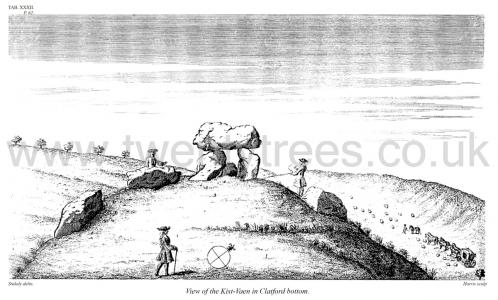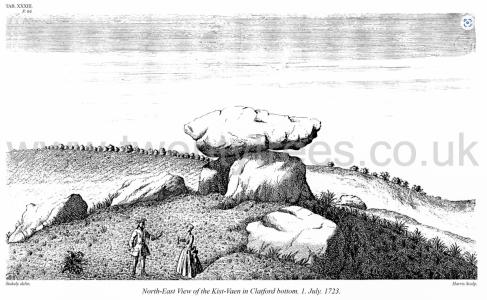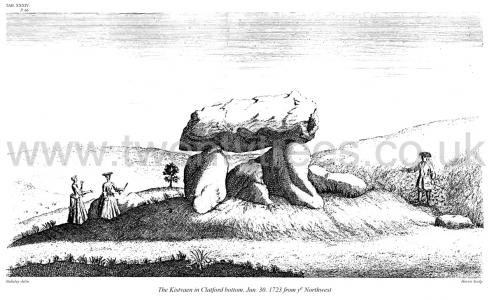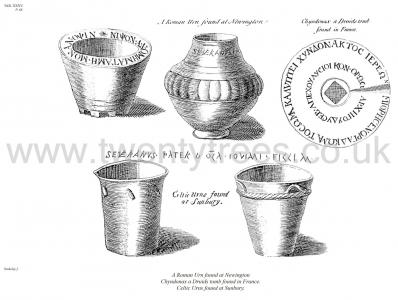Avebury Chapter XII
Avebury Chapter XII is in Avebury A Temple of British Druids, With Some Others, Described by William Stukeley.
The second sort of temples called Dracontia, like that of Abury, have been built frequently in old times. The traces of them pursued. Part of the history of Phut, third son of Cham. A genealogy of the most ancient sacred and heathen families. Phut had a fleet of ships upon the Mediterranean. The Typhon, Typhis, Python of antiquity, called Apollo Pythius after death. He was a builder of these serpentine temples. Like the emperor Augustus in countenance. He erected the first patriarchal temple at Delphos, a Dracontium. Parnassus originally Larnassus, which is no other than our Hakpen of Abury. The sabbath observed there originally. Ææas, a son of Phut's, built the Dracontium at Colchis. Perseus, another son of his, bore the sacred hierogram, the circle, snake, and wings, in his shield; whence the Medusa's head.
Zoroaster Magus, in Euseb. p. e. II. 7. Plato, Porphyry, and others of the old philosophers, define God to be every where and no where, who fills all space, and is contained in none; "from whom came all things that are, and which are not yet; eternal, immutable, omnipresent, incomprehensible, immaterial, without parts, beginning or end." If we put this definition into a geometrical figure, in order to form a symbol, we62 cannot possibly do it better than by describing the circle. A circle then in hieroglyphics means, divine; but particularly, as it is the most perfect and comprehensive of all geometrical figures, they designed it for the symbol of the first and supreme being; whose resemblance we cannot find, whose center is every where, and circumference no where. It well pictured out, as Abenephi the Arabian and others assert, the divine nature of God.
Therefore this figure of the serpent and circle in their doctrine, aptly means the divine creator, or the creator descended from the supreme. For tho' the deity was author of all things, yet more immediately this SON or WORD of the supreme was the architect of the universe.
And this we find exactly consonant to the scripture doctrine. So that it seems very evident to me, the most important of divine truths admitted in the christian church, were imparted to the first race of mankind, the patriarchal church, which two are in reality but the same.
We learn repeatedly from Sanchoniathon, Porphyry, and other ancient authors quoted by Eusebius in the præparatio evangelica, that the first sages of the world had just and true notions of the nature of the deity, conformable to those of the Christians: That, in their hieroglyphic way of writing, they designed the deity and the mysterious nature thereof, by the sacred figure of the circle, snake, and wings. Of these, the circle meant the fountain of all being, the invisible supreme, who had no name. The serpent symbolized the son, or first divine emanation from the supreme. This they called by the name of Ptha, which is derived from the hebrew, meaning the WORD. The wings symbolized that divine person or emanation from the former, commonly called anima mundi, but the Egyptians called him KNEPH, which in hebrew signifies winged.
Thus the old authors that speak of these things are to be understood, though they are confused, not rightly apprehending the bottom of the matter. And this hieroglyphic figure, in the whole, was called Knephtha.
But this knowledge of the nature of the deity, the most valuable depositum which could be communicated to mortals, was first perverted into idolatry; therefore God almighty forbore revealing himself further on that head, in an explicit manner, 'till the fulness of time arrived, the Christian dispensation. But those people who preserved themselves from idolatry, among which I reckon our Druids, retained that knowledge thereof which had already been imparted, of which this sacred figure of the alate and serpentiferous circle was, as it were, a seal; which they stamped upon these most lasting monuments, their temples. And I doubt not but they somewhat improved the notions they had thereof, by reasoning, in the manner I shall speak of Chap. XV.
Abury is not the only temple in Britain formed on this design of the circle and serpent. I saw another at Shap in Westmorland, when I travelled thro' the place, anno 1725, with Mr. Roger Gale (age 50). But I had no opportunity of examining into it.
There is another, as I take it, at Classerness, a village in the island of Lewis, between Scotland and Ireland. I took a drawing of it from Mr. Lwydd's travels; but he was a very bad designer, and having no knowledge of the purport, makes the representation still worse. The circle to which it belongs is 20 cubits in diameter. There is a central obelisc. A part of the snake remains going from it, which he calls an avenue. He did not discern the curve of it, no more than that of Kennet avenue, which he likewise has drawn in the same collection, as a straight line. It seems to 63me that the circle was double, or two concentric. I shall print it in the succeeding volume.
Table XXXII. View of the Kist-Vaen [Devil's Den Long Barrow [Map]] in Clatford bottom.

No doubt but there are more in the britannic isles. I propose in this chapter to deliver my notions concerning them in the more eastern parts of the world, of which are many traces in ancient writing; avoiding prolixity as much as possible.
The practice of building these serpentine temples was used by the patriarchs, perhaps near the beginning of the world. I have some proof of their being ancienter than the flood; but shall not at present insist on it. The first person I shall take notice of on this account is Phut, a brother of Canaan, son of Cham. Phut was a person of much greater eminence in antiquity, than vulgarly thought. But would we know anything of the particular memoirs of this man, or of any other his relations and coevals, we have nothing left us for it but heathen story.
Tho' the Phœnicians, and our Druids, as well as the Egyptians too, had the earliest use of alphabet writing, yet none of these nations have transmitted to us any memoirs of themselves. And for what little knowledge we have of them, besides their monuments, we are altogether indebted to the Greeks, that received these arts from them. They happily improved art and science, sculpture and writing, so as to hand down to us most of the ancient history we know, beside the bible. Still this misfortune attended them, that they improved the symbolical method of writing, which they learned from the Phœnicians and Egyptians, to that monstrous pitch, as to produce what we call by the general name of mythology. It was but very late that they came to write true history: so that the whole of the ancient history of the nations they write of, is inveloped in this perplexing mythology.
Yet we should be highly to blame, if we absolutely neglected it. 'Tis all we can have of prophane antiquity. 'Tis more commendable for us to study to extricate it from its symbolic mystery, and find out the open truth. Those that have succeeded best therein, find much agreement between it and the scripture history, as far as they are concurrent.
'Tis from this mythology, chiefly, that I can pretend to discourse any further, concerning these great works I have been describing. I shall endeavour to do it with all the brevity and perspicuity possible, as becomes such sort of discourses. Yet I despair not of finding out a good deal of true history. I shall not answer for all. And a great deal of candour is necessary in the reader, if he would have either pleasure or instruction in it. Yea, says a predecessor in these kind of inquiries, Dr. Dickenson, Delph. Phœnic. "if we look over the greek mythology with proper sagacity, we shall easily discover many footsteps of true religion."
"A fable is an artificial discourse, consisting of the marvellous, and a philosopher, in some sort, is a lover of such," says the great philosopher, Metaphys. I. 2.
There are vast treasures of ancient knowledge in mythology, especially of history both sacred and civil. 'Tis all that we have left of heathen history of the most ancient times, and 'tis worth our while to shake off the rubbish, and pick out the useful part. The learned labours of Bochart, Selden, Marsham, Huetius, Gale, Cumberland, Banier, and many more, shew us its utility. And we must pardon them if, in some things, they have gone beyond the golden medium, we ourselves will be content to err somewhat with those great names.
Phut, son of Cham, was a person of eminence, tho' not taken notice of so much as he deserves. I think it much to our purpose to recite some part of his history. He is the Apollo mentioned by Sanchoniathon, son of Cronus, who is Cham, as is demonstrated beyond doubt by bishop Cumberland, in his posthumous works; he is said to have been born in Peræa, i. e. the country towards the Euphrates: his third son; as likewise delivered by Moses. From the word Phut, he was called Python, by a little transposition natural in pronouncing a difficult name; and, by a like transposition, Typhon.
Apollo Pythius was the son of Ammon, that is Cham, says Lucius Ampelius, in libro memoriali. Plutarch de Isid. & Osir. writes, that Typhon was brother to Osiris, who was undoubtedly Misraim, son of Cham. The like by Diodorus Siculus.
To facilitate the understanding of antiquity, I here present the reader with a genealogical table of the great personages we are going to treat of. I could produce the evidences that prove each particular descent, in a strictly heraldical way, but it would now take up too much of our time.
Table XXXIII. North-East View of the Kist-Vaen [Devil's Den Long Barrow [Map]] in Clatford bottom. 1. July. 1723.

Described. The GENEALOGY.

Phut was the first most celebrated navigator of antiquity, built a fleet of ships, began to carry colonies into the countries on the Mediterranean sea. Strabo in IX. tells us the history of him from Ephorus, a very ancient historian. He says Phut or Apollo travelled the earth, and came to the rude inhabitants of Parnassus. His business was to bring men to civility and manners, to use corn for their food.
Pindar writes of him,
——He travelled o'er earth and sea, setting watch-towers on hill-tops, among the nations, consecrating temples, and building groves.
Lycophron mentions Typhon's watch-towers in Arimis, which probably is the Peræa of Sanchoniathon, the east part of Syria, where Homer says the ευνη, or bed of Typhon was, in a field abounding with oaks. 'Tis not unusual for Apollo to be represented in the character of a military captain. Hygin. fab. 140. And he really was a leader of a vast colony of his people into Egypt, then possessed by his elder brother Misraim. Of this more hereafter. Of him speaks Seneca in Medea,
Ausus Tiphys pandere vasto [Typhius ventured to spread the waste]
Carbasa ponto, legesque novas [A canvas on the bridge, and new laws]
Scribere ventis—— [Write to the winds]
Again,
Tiphys in primis domitor profundi. [Typhus is the first tamer of the deep]
Jerem. xlvi. 9. the Libyans of Africa are in the original Phut. The Lydians there are the people or posterity of Lud, Thoth, his brother.
Apollodorus I. 4. writes, that Elios, our Phut, married Rhode daughter of Neptune, who was really Tarshish son of Javan, son of Japhet. From her he denominated the celebrated island, where, to his honour, was erected by posterity, the most stupendous statue in brass that ever was in the world, in any metal or other matter; being seventy cubits in height, whence all great statues have been called Colosses. The Argonauts in Apollonius I. sacrifice to Apollo the patron of navigation; in Artemidorus, Oniro II. 35. called Apollo Delphinius; that author says it means long voyages. Pausanias in Bœoticis gives him the same sirname. Hence, I apprehend, the dolphin, his cognizance, was placed in the heavens.
In face, he was like to Augustus. I have several Rhodian coins in silver and brass, of different sizes, in all which he is pictured. Nor need we be scrupulous in thinking them a good resemblance. For the Telchines, inhabitants of Rhodes, are said to be the first makers of images. And we may at this time of day, have the satisfaction of seeing an infinite number of representations of him, in the coins, busts, and images of Augustus, particularly the famous statue of Apollo in the Vatican garden at Rome, made from the emperor's face. Therefore we may well admit of it for the heroical effigies of Phut.
Bochart thinks, he fixt his habitation first at Delos, and his family, and thence the fable of his being born there. I have an ancient brass coin, with the heroical effigies of his mother Latona. Her head in the adverse ΙΕΡΑ ϹΥΝΚΛΕΙΤΟϹ, reverse, the goddess sitting, a hasta pura held oblique in her right hand. ΛΗΤΩΤΡΙΠΟΛΕΙΤΩΝ.
Table XXXIV. The Kistvaen in Clatford bottom. Jun. 30. 1723 from ye Northwest.
 Table XXXIV. The Kistvaen in Clatford bottom. Jun. 30. 1723 from ye Northwest.
Table XXXIV. The Kistvaen in Clatford bottom. Jun. 30. 1723 from ye Northwest.
In this island of Delos he had a most magnificent temple, built to him in after ages, when idolatry began. The noble remains of it are to be seen there still. For his great fame and exploits, posterity consecrated him, calling him the son of Jupiter, meaning Jupiter Ammon, or more properly of Saturn.
But in no place was Phut more famous than in Phocis. He planted the country about the mountain Parnassus, where he built, as I apprehend, a great serpentine temple, like ours of Abury, at the bottom of that mountain, by the city of Delphos. This I gather from the Greek reports of the serpent Python of an immense bulk, bred of the slime left on the earth, by the general deluge, which Apollo here overcame; and instituted annual games called Pythia, plainly from his own name. These were the first and most ancient games we hear of in Greece.
Change the places, Abury for Parnassus, and we have both the natural, as well as chronological history of the place; a vast temple in form of a serpent, made out of stones left on the surface of the earth after the deluge: not only so but the very name too. The name of Parnassus was originally Larnassus, says Stephanus Byzantinus. The letter L is not a radical in this word, as the learned Dickenson observes in Delphi phœnic. therefore the word is Harnassus, Har is a headland or promontory of a hill, and nahas a serpent, which is no other than our Hakpen of Abury. Whence we conclude, the snaky temple extended its huge length along the bottom of Parnassus, and laid its head upon a promontory of it, just as ours at Abury, on Overton-hill. Whence Ovid not merely poetically, describes it;
——Tot jugera ventre prementem. [So many acres of belly pressing??]
This was the original patriarchal temple dedicated to the true God, where oracles were originally given by Themis says Apollodorus I. 4. Which name I take to be a corruption made in after times from the Jewish Thummim, for a divine and true oracle; which Dickenson asserts to have been at this place, page 104. in time turned into an idolatrous one. Many built one after another, as the former ones were sacked and destroyed.
The report of the mountain having been called Larnassus, is another argument of the high antiquity of this first serpentine temple here built by Phut, and throws us up to the patriarchal church, and to the times immediately after the great deluge. Stephanus of Byzantium before quoted, says it: and the interpreter of Apollonius, and Ovid makes Apollo's engagement with Python to be immediately after the flood. They pretend the name Larnassus comes from Larnax, the ark of Deucalion landing here, agreeable to the Greek method of drawing all antiquity to themselves.
The central obeliscal stone in some of the circular works here, which was the Kebla, as in the southern temple of Abury, was afterward, in idolatrous times, worshipped at Delphos for the statue of Apollo, as Clemens Alexandrinus writes, Strom. I. 'till art and Grecian delicacy improved and produced elegant images, like that aforementioned of the vatican, and innumerable more, still remaining.
In Vaillant's colony coins vol. I. page 242. is an elegant coin struck at Cæsarea, to the emperor Antoninus Pius. On the reverse, Apollo standing, leans on a tripod, holds in his right hand a snake extended. The learned author is at a loss to explain it, therefore I may be allowed to give my opinion, that it relates to our present subject.
It was the method of the ancient planters of colonies, to begin their work with building temples, I mean our patriarchal temples, for there were then no other. And they instituted festival and religious games, which contributed very much to polish and civilize mankind, and make them have a due notion and practice of religion, without which it is impossible for any date to subsist. Of this Strabo writes very sensibly in IX. treating on this very place. The Pæanick or Pythian are the most ancient games we have any account of. Strabo writes very largely concerning them.
These great festivals were at the four solar ingresses into the cardinal signs, which were the times of publick sacrificing, as I suppose, from the creation of the world. The Pythian festival was celebrated on the sixth day of the Athenian month Thargelion, Delphick Busius. 'Tis between April and May.
But we learn, from the scholiast of Pindar, prolegom. ad Pythia, that Apollo instituted the Pythia on the seventh day after he had overcome the serpent Python; and that at Delphos they sung a hymn called Pæan to Apollo every seventh day. The Athenians did the like, every seventh day of the moon, whence Hesiod's
Ἑβδόμη ἱερὸν ἦμαρ——[Holy Week]
Because, says he, Apollo was born on that day.
The learned Gale observes from this, in his court of the Gentiles, p. 150. that it means the sabbath as the patriarchal custom, before the Jewish institution. Usher before him, of the same opinion, in his discourse on the sabbath. Porphyry in his book concerning the Jews, quoted by Eusebius pr. ev. I. 9. tells us, the Phœnicians consecrated one day in seven as holy; he says indeed, it was in honour of their principal deity Saturn, as they called him, and Israel. We are not to regard his reason, any more than Hesiod's aforementioned, but his testimony of a matter of fact, has its just weight. He means to prove a custom older than Judaism.
I take all this to be an illustrious proof of the patriarchal observation of the sabbath, before the Mosaick dispensation. Their sabbath was intirely like our Christian, the greatest festival of all, and deservedly the most to be regarded, as being religion properly, or practical religion.
We cannot easily determine on what day the patriarchal sabbath was kept, Hesiod's reason being the birth day of Apollo, pleads for Sunday; Porphyry's for saturday, consequent to which thus Martial XII. 63.
In Saturnum.
Antiqui Rex magne poli, mundique prioris, [The ancient King of the great pole, and of the former world,]
Sub quo pigra quies, nec labor ullus erat. [Under which there was a lazy rest, and no labor.]
But both shew evidently the antiquity of the hebdomadal division of time, and the planetary names of the week days, and the primæval sabbatical rest. Pausanias in atticis writes, at Megara was a statue of Apollo carrying the Docimæ or tithe, another patriarchal usage.
The work of Phut's building an enormous serpentine temple, was called killing or overcoming the huge serpent Python, properly son of the earth.
——Et te quoque maxime Python [And you, too, especially Python]
Tum genuit: populisque novis incognita serpens [ ]
Terror eras. Tantum spatii de monte tenebas. [You were a terror. You were only a short distance away from the mountain] Ovid. Met.
Publick sacrifices, games, hymns, a sabbatical observance being there celebrated; we have just reason to think all the like were observed by our Druids at Abury, especially considering they were of Phœnician original.
Table XXXV. A Roman Urn found at Newington. Chyndonax a Druids tomb found in France. Celtic Urns found at Sunbury.
 Table XXXV. A Roman Urn found at Newington. Chyndonax a Druids tomb found in France. Celtic Urns found at Sunbury.
Table XXXV. A Roman Urn found at Newington. Chyndonax a Druids tomb found in France. Celtic Urns found at Sunbury.
To conclude this chapter, this labour of Phut's is told in many places. Some say it was in Mysia, in Phrygia others, again in Cilicia, in Pithecusa, in Bœotia; Strabo xiii. writes, that it was in Syria; and there seems to have been a serpentine temple on the river Orontes of Antioch, for it was called originally Typhon and Οφιτης, as Strabo writes, xvi. and Eustathius in Iliad, p. 262. Basil. and in Dionysium. The story is of Typhon a huge serpent slain there by a thunderbolt from Jupiter, near a sacred cave called Nymphæum.
The meaning of all this, seems to be, that Phut in person, or his people built them in all these places. Ææas a son of Phut's, built the serpentine temple at Colchis.
Perseus was a son of Demaroon, born in Egypt, Euseb. p. e. II. 1. he was coæval with Phut, and bore in his shield the sacred hierogram, and he probably built of these Dracontia. From this the poets made their fable of Medusa's head, and that it turned men into snakes. Hesiod in the description of Hercules's shield, thus paints him in English.
"As he went, his adamantine shield sounded, and tinkled with a loud noise. In a circle two dragons were suspended, lifting up their heads." Johannes Malala makes Perseus institutor of the Magi, who were the patriarchal priests of the east. He calls the river of Antioch abovementioned Dracon.